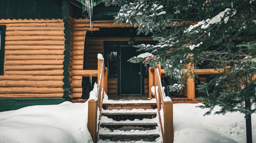A house-hunting checklist that's sure to save you money on old log home inspections.
By Andrew Wormer If you're buying an older log home, the home inspection typically required by your lender usually will help identify potential trouble spots before you sign on the dotted line. But not all home inspectors are familiar with the idiosyncrasies of a log home; sometimes they miss structural defects, and sometimes they become overly alarmed by problems that are easy to correct. If you're in the market for a log home, you're going to be looking at more than one, and you don't want to pay to have each one inspected. Here is a checklist of things you can look for?and look out for?when you're house-hunting.
If you're buying an older log home, the home inspection typically required by your lender usually will help identify potential trouble spots before you sign on the dotted line. But not all home inspectors are familiar with the idiosyncrasies of a log home; sometimes they miss structural defects, and sometimes they become overly alarmed by problems that are easy to correct. If you're in the market for a log home, you're going to be looking at more than one, and you don't want to pay to have each one inspected. Here is a checklist of things you can look for?and look out for?when you're house-hunting.
1. Look at the quality of the exterior finish.
Most experts agree that the best indicator of a log home's overall condition is the quality of the exterior finish. Look for fading, peeling or cracking in the finish. Also, look for black deposits on the logs, which can indicate mold, mildew or dirt.2. Look out for logs that are in contact with the ground.
Besides acting like a sponge and wicking up decay-causing moisture, logs that touch the ground provide an easy route for insects to enter the home.3. Look for appropriate and authentic repairs.
If you're buying a very old log house with historical value, make sure that the maintenance and repairs are authentic. Be aware that replacement supplies can be difficult to locate.4. Look out for hidden rot in exterior logs.
One idea: Bring a hammer with you and simply tap on the logs (get the home owner's permission first). You should be able to hear the difference between the sharp, reverberating knock of a solid log and the hollow sound of a log that's rotting from the inside out.5. Look for overhangs.
Generous eaves (preferably 24 inches for one-story houses and 36 inches for two-story houses) and rakes help prevent rain and snow from dripping on the side of the building and keeping water runoff farther away from the foundation6. Look out for signs of insect infestation.
Signs can include the presence of small round holes, talc- or sawdust-like residues, and of course the insects themselves: termites, carpenter ants, carpenter bees and powder post beetles to name a few.7. Look for gutters.
While not everyone likes the look of gutters, they do help control water runoff, protecting windows, doors and logs. Make sure that they are in good condition and aren't clogged. Downspouts should drain water well away from the house foundation. Also, a site that slopes slightly away from the house drains away from the foundation.8. Look out for decks.
When water drips down off a roof and hits a deck, it splashes back onto the side of the house, so this is a good area to check for water damage and decay.9. Look out for windows and doors that stick.
Doors that stick in their frames are an indicator of settlement that hasn't been corrected. Windows that seem racked or don't open or close easily are another indicator.10. Look for lots of porches.
Porches are a perfect fit for a log house. They shelter the logs from sun and rain, minimizing the wetting and drying cycle and shielding the wood from the damaging effects of ultraviolet rays.11. Look out for missing chinking and sloppy caulk.
Poor attention to these details can be indicative of a general lack of maintenance.12. Look out for sagging roofs.
A drooping roof ridge or sagging roof planes are indicative of structural defects. Possible causes include uncorrected settling, undersized roof rafters and missing collar ties.13. Look out for checking.
As logs dry out, they crack and check, opening up water infiltration routes to the log's interior. Any upward-facing crack or check should be sealed with caulk.14. Look for flame retardant.
A flame retardant applied to both the roof and sides of the house may significantly reduce the risk of fire, as well as lower your insurance rates.15. Look for documentation.
A visit to the local town clerk's office can tell you how many times the home has been bought and sold (a house that changes hands frequently is less likely to be well-maintained than one that has remained with a single owner). Also, ask the owner for maintenance records and receipts.Andrew Wormer is a contributing editor with Fine Homebuilding magazine.











